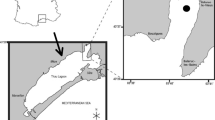Abstract
In oligotrophic waters, not only community structure but also physiological properties of heterotrophic bacteria are influenced by the concentration of organic matter.
The relationship between growth rate of two facultatively oligotrophic strains ofAeromonas sp. No. 6 andFlavobacterium sp. M1 was studied in comparison with that of two eutrophic strains ofEscherichia coli 7020 andFlavobacterium sp. M2. These strains had two or three different substrate constants (Ks values) depending on substrate concentrations: Ks values for the two former were remarkably lower than those for the two latter. For instance, Ks value forAeromonas sp. No. 6 was about 8.9μM when substrate concentration was greater than 53μM and about 1.1μM when substrate concentration was less man 53μM. InE. coli the Ks value was about 260μM at greater than 5600μM and about 47μM at less than 5600μM substrate concentration.
Uptake kinetics ofAeromonas sp. grown in a medium containing 2.7 mM glutamate (H-cell) and 0.11μM glutamate (L-cell) have been determined for the intact cells. H-cell had two distinct values of Km for glutamate assimilation and respiration, and L-cell had three distinct values of Km for glutamate assimilation and respiration: In H-cell Km of assimilation was 2.8×10−7 M and 1.5×10−4 M, and Km of respiration was 2.3×10−7 M and 1.7×10−4 M; in L-cell Km of assimilation was 7.4×10−8 M, 8.3×10−6 M, and 1.3×10−4 M, and Km of respiration was 2.5×10−7, 8.9×10−6M, and 1.7×10−4 M. More than 60% of glutamate taken up by the H- and L-cells was respired when the substrate concentration was less than 10−6 M, although at greater than 10−6 M, 50% and 30% of glutamate was respired by H-cells and L-cells, respectively. These results suggest that the facultatively oligotrophic bacteria grow with high efficiency in environments with extremely low nutrient concentration, such as oligotrophic waters of lakes and ocean, as compared with in their growth in conditions of high nutrient concentraton, such as nutrient broth.
Similar content being viewed by others
References
Akagi Y, Taga N (1980) Uptake of D-glucose and L-proline by oligotrophic and heterotrophic marine bacteria. Can J Microbiol 26:454–459
Carlucci AF, Shimp SL (1974) Isolation and growth of a marine bacterium in low concentrations of substrate. In: Colwell RR, Morita RY (eds) Effect of the ocean environment on microbial activities, pp 363–367
Hamilton RD, Morgan KM, Strickland JDH (1966) The glucose uptake kinetics of some marine bacteria. Can J Microbiol 12:995–1003
Ishada Y, Kadota H (1977) Distribution of oligotrophic bacteria in Lake Mergozzo. Bull Jpn Soc Sci Fish 43:1417–1424
Ishida Y, Kadota H (1979) A new method for enumeration of oligotrophic bacteria in lake water. Arch Hydrobiol Beih Ergebn Limnol 12:77–85
Ishida Y, Kadota H (1981) Growth patterns and substrate requirements of the first isolated naturally occurring obligate oligotrophs. Microb Ecol 7:123–130
Ishida Y, Shibahara K, Uchida H, Kadota H (1980) Distribution of obligately oligotrophic bacteria in Lake Biwa. Bull Jpn Soc Sci Fish 46:1151–1158.
Jannasch HW (1968) Competitive elimination of Enterobacteriaceae from seawater. Appl Microbiol 16:1616–1618
Kuznetsov SI, Dubinina GA, Lapteva NA (1979) Biology of oligotrophic bacteria. Annu Rev Microbiol 33:377–387
Menzel DW, Vaccaro RF (1964) The measurement of dissolved organic and particulate carbon in seawater. Limnol Oceanogr 9:138–142
Sugita H, Ishida Y, Kadota H (1979) Kinetic analysis of promotive effects of kaolin particles on growth of the aquatic bacterium. Bull Jpn Soc Sci Fish 45:1381–1383
Author information
Authors and Affiliations
Rights and permissions
About this article
Cite this article
Ishida, Y., Imai, I., Miyagaki, T. et al. Growth and uptake kinetics of a facultatively oligotrophic bacterium at low nutrient concentrations. Microb Ecol 8, 23–32 (1982). https://doi.org/10.1007/BF02011458
Issue Date:
DOI: https://doi.org/10.1007/BF02011458




